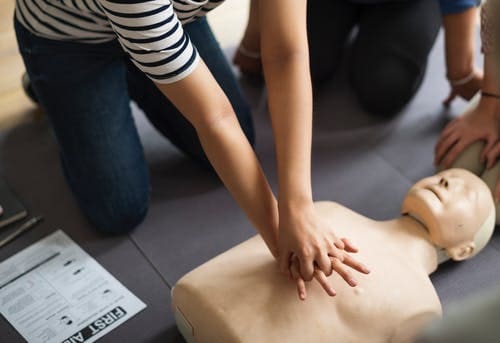
Complications of CPR
Cardiopulmonary resuscitation, or CPR, is a technique used to support the circulation of blood and oxygen in the body of a victim who is not breathing and does not have a pulse. CPR is physically invasive for the victim and techniques used during CPR carry risks and the chance of complications. Ultimately, the risk of complications is small and should not deter the use of CPR for a victim in need.
Broken Bones
Rib fractures are the most common complication of CPR. Chest compressions administered during CPR are given quickly and with enough force to compress the chest about 1 inch in depth. This provides pressure to the ribs, which can be strong enough to cause ribs to fracture. Victims who are elderly, small in stature or children have the highest risk of developing rib fracture during chest compressions. Additionally, the chest bone, or sternum, also endures pressure and stress during chest compressions and can fracture as well.
Internal Injuries
Internal organs lie within the area pressured by chest compressions. As the chest is compressed during CPR, ribs and chest bones can break, puncturing the lungs and liver. Additionally, internal bruising of the heart and liver can occur.
Vomiting and Aspiration
As chest compressions are administered, pressure builds inside the body, which can force stomach contents up the esophagus and result in vomiting. This causes the risk of aspiration, or absorbing the vomit into the respiratory system. Aspiration is a serious complication which makes it difficult to provide the victim with adequate air and can ultimately damage lung tissue or result in infection, like pneumonia.
Body Fluid Exposure
CPR presents the risk of exposure to body fluids. Providing mouth-to-mouth rescue breathing to a victim without use of a mask results in saliva exposure between victim and rescuer. Blood and vomit may also be present during CPR, which carries the risk of communicable disease such as hepatitis and AIDS. The American Heart Association encourages the use of a barrier mask when administering rescue breathing during CPR for protection against contamination.
Gastric Distention
Rescue breathing during CPR provides air directly into the lungs of the victim. If air is delivered too forcefully or for too long a time, the victim can accumulate air build-up in the stomach, called gastric distention. Gastric distention causes the stomach to swell and places pressure on the lungs. CPR efforts can become complicated if gastric distention occurs due to reduced ability to deliver adequate oxygen to the lungs, and can also result in vomiting and aspiration. Gastric distention can often be avoided by proper, careful administration of rescue breathing during CPR.
Source: https://www.livestrong.com/article/31439-complications-cpr/
